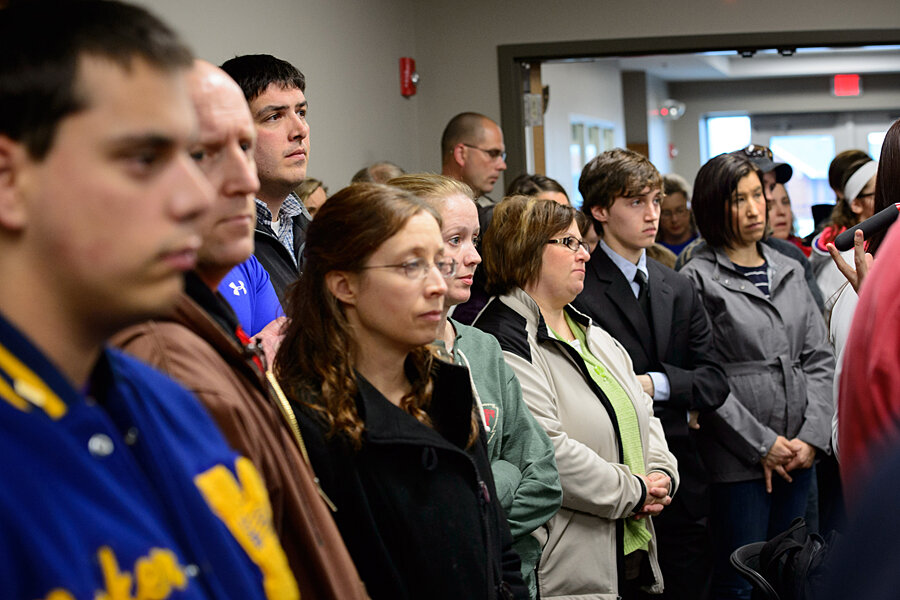Minnesota school massacre averted: template for community vigilance?
Loading...
| Atlanta
Outwardly, just about everyone in Waseca, Minn., thought John LaDue was a typical high school kid when, in fact, police allege the 17-year-old guitarist appears to have been on the brink of infamy.
On Thursday, Minnesota prosecutors charged the teenager with four counts of attempted murder and possession of bombs after investigators discovered a nearly year-long plot to kill his family, set a diversionary fire, bomb his school, kill the school resource officer, and then, as he told police, use high-powered rifles to “kill as many students as I can.”
Amid his journals, John LaDue also wrote about his admiration for the two teenagers who carried out the attack on Columbine High School in 1999.
Whether LaDue actually had the will to carry out the planned attack can’t be known, but police say he had the resources, planning, skills, tactics, materials, and impetus to go forward with it “within a week or two,” according to one police official.
Following many actual mass shootings, friends, relatives, school officials, and classmates often bemoan in hindsight the missed signals and failed chances to thwart the hidden plans of the gunmen. Waseca, too, is, in its relief, having to deal with the twisted scenario that secretly metastasized in their midst, apparently ready to explode. “Too scary to put into words,” one Waseca parent told the Minnesota Star-Tribune.
But even as the small Minnesota town (population around 10,000) reckons with a potential mass murderer so familiar, the details of how police caught LaDue before the teenager could set his plot in motion contain at least one lesson in communal vigilance, emblematic of how one watchful person had the power and wherewithal to stop a national tragedy.
"This case is a classic example of citizens doing the right thing and calling the police when things seem out of place,” the Waseca Police Department said in a statement Thursday. “By doing the right thing, unimaginable tragedy has been prevented.”
Waseca resident Chelsie Schellhas said she was washing dishes around dinnertime Tuesday when she saw a tall blond man with a backpack walking through backyards, holding a bag of fast food. She kept on watching as the man entered a MiniMax storage facility, and then struggled to open the door to one of the storage lockers. Inside, Ms. Schellhas could see bags of trash. She called 911.
It all “just didn’t seem right to me,” she told the Minneapolis Star-Tribune. “We see people come and go with their trucks, and they don’t come on foot and cut through people’s backyards. It was like he was blatantly trying not to be seen. That’s why I thought it was odd.”
When officers arrived, they found LaDue, who at first appeared to taunt them and later said he would have shot at the officers if he’d had one of his guns handy. Inside the locker police found a lantern-lit scene of ammo boxes, a pressure cooker, a bomb ingredient known as iron oxide, and a scale. Later, at LaDue’s home, they found three prepared bombs and seven firearms, with ammo.
“Intuition worked in this case,” says Steve Albrecht, a threat assessment expert and author of the book “Ticking Bombs” about workplace and school shooters. “The idea that you can’t do much as just one person is wrong; you can do a lot. Something you say might become part of the momentum that gets cops or schools to investigate. Oftentimes we get stuck on motive [for school shootings]; what we’ve got to focus on is how to interrupt the opportunity.”
To be sure, trying to stop potential killers by just investigating behavior is often fruitless, experts say. After a mass stabbing that wounded more than 20 kids at a Pittsburgh area school on April 9, initial befuddlement over how a “good kid” like the alleged stabber, Alex Hribal, could have done something so violent gave way to clues about a darker side of the boy’s personality. That included a manifesto of sorts found in his locker where he wrote he “can’t wait” to kill his classmates.
In LaDue’s case, neighbors had complained about him practicing throwing axes and knives against a tree in his yard. And “his taste in movies was dominated by blood, gore, combat and fisticuffs. His favorite authors were Stephen King and the master of literary darkness, Edgar Allen Poe,” writes CNN, judging by his Facebook account.
While in hindsight such details may seem revelatory, those actions and “likes” hardly by themselves rise to the level of catalyzing police or school interference, experts note.
“The toughest challenge is, these guys don’t usually draw attention to themselves with behavior,” says Mr. Albrecht. “The kid fighting with the community is the one who doesn’t say anything to his targets. And when that kid starts moving from ideas to actions, that’s the biggest warning sign.”
Criminologists say foiled plots like the one in Waseca also underscore official findings that communities and individuals have the power to stop potential mass killers, even when mass violence writ large often seems random, arbitrary and senseless.
“The horrific consequences of mass murder are what drive concern for prevention even when it is recognized that these events are likely to be very difficult to predict or prevent,” writes John Klofas, a Rochester Institute of Technology criminologist, in a recent white paper for the Center for Public Safety Initiatives. “The mathematical reality, however, does not limit the responsibility for continuously seeking ways to reduce the potential for such events in one’s own community.”








